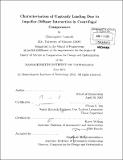| dc.contributor.advisor | Choon S. Tan. | en_US |
| dc.contributor.author | Lusardi, Christopher (Christopher Dean) | en_US |
| dc.contributor.other | Massachusetts Institute of Technology. Computation for Design and Optimization Program. | en_US |
| dc.date.accessioned | 2012-09-13T18:58:03Z | |
| dc.date.available | 2012-09-13T18:58:03Z | |
| dc.date.copyright | 2012 | en_US |
| dc.date.issued | 2012 | en_US |
| dc.identifier.uri | http://hdl.handle.net/1721.1/72869 | |
| dc.description | Thesis (S.M.)--Massachusetts Institute of Technology, Computation for Design and Optimization Program, 2012. | en_US |
| dc.description | Cataloged from PDF version of thesis. | en_US |
| dc.description | Includes bibliographical references (p. 89-90). | en_US |
| dc.description.abstract | Time dependent simulations are used to characterize the unsteady impeller blade loading due to imipeller-diffuser interaction in centrifugal compressor stages. The capability of simulations are assessed by comparing results against unsteady pressure and velocity measurements in the vaneless space. Simulations are shown to be adequate for identifying the trends of unsteady impeller blade loading with operating and design parameters. However they are not sufficient for predicting the absolute magnitude of loading unsteadiness. Errors of up to 14% exist between absolute values of flow quantities. Evidence suggests that the k - e turbulence model used is inappropriate for centrifugal compressor flow and is the significant source of these errors. The unsteady pressure profile on the blade surface is characterized as the sum of two superimposing pressure components. The first component varies monotonically along the blade chord. The second component can be interpreted as an acoustic wave propagating upstream. Both components fluctuate at the diffuser vane passing frequency, but at a different phase angle. The unsteady loading is the sum of the fluctuation amplitude of each component minus a value that is a function of the phase relationship between the pressure component fluctuations. Simulation results for different compressor designs are compared. Differences observed are primarily attributed to the amplitude of pressure fluctuation on the pressure side of the blade and the wavelength of the pressure disturbance propagating upstream. Lower pressure side pressure fluctuations are associated with a weaker pressure non-uniformity at the diffuser inlet as a result of a lower incidence angle into the diffuser. The wavelength of the pressure disturbance propagating upstream sets the domain on the blade surface in which the phase relationship between pressure component fluctuations is favorable. A longer wavelength increases the domain over which this phase relationship is such that the amplitude of unsteadiness is reduced. | en_US |
| dc.description.statementofresponsibility | by Christopher Lusardi. | en_US |
| dc.format.extent | 90 p. | en_US |
| dc.language.iso | eng | en_US |
| dc.publisher | Massachusetts Institute of Technology | en_US |
| dc.rights | M.I.T. theses are protected by
copyright. They may be viewed from this source for any purpose, but
reproduction or distribution in any format is prohibited without written
permission. See provided URL for inquiries about permission. | en_US |
| dc.rights.uri | http://dspace.mit.edu/handle/1721.1/7582 | en_US |
| dc.subject | Computation for Design and Optimization Program. | en_US |
| dc.title | Characterization of unsteady loading due to impeller-diffuser interaction in centrifugal compressors | en_US |
| dc.type | Thesis | en_US |
| dc.description.degree | S.M. | en_US |
| dc.contributor.department | Massachusetts Institute of Technology. Computation for Design and Optimization Program | |
| dc.identifier.oclc | 808368547 | en_US |
